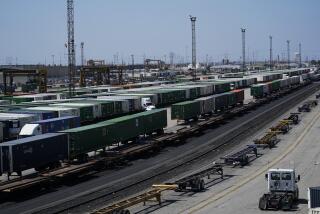Union Pacific Reorganization Designed to Cut Port Delays
- Share via
Union Pacific has loosened the supervisory grip of its top-down operating system and given broad authority to regional divisions in a move aimed in part at averting the costly rail delays and cargo pileups that cost Southern California’s economy an estimated $750 million since last year.
“We feel the railroad is too large to be managed from one central location,” company spokesman John Bromley said of the company’s announcement this week to form three regions, including one in the West. “Basically it is putting the administration of the railroad out where the action is.”
The embattled company, which has been plagued by massive nationwide service problems since merging with Southern Pacific, is hoping the decentralization scheme will prevent further problems in California, which accounts for the railroad’s largest volume of import cargo.
“California is one of the places where we are concentrating the most,” Bromley said.
Local economists and others said UP’s commitment to California and the West is crucial. The nation’s busiest seaports at Los Angeles and Long Beach are an important economic engine in Southern California, and they have been hard hit by Union Pacific’s service problems.
Union Pacific “is a critical part of our region’s economy because of the international trade at the ports,” said Jack Kyser, chief economist at the Los Angeles Economic Development Corp. “We are under constant attack [by other ports] for our international trade,” and shipping glitches don’t help.
Indeed, last year the delays cost the region’s economy about $750 million, Kyser said.
A number of the 300,000 local jobs generated by the ports could be threatened, he said, if continued delays prompt shippers to seek other West Coast ports such as Seattle and Tacoma, Wash., to move their cargo.
Still, Southern California itself is the end destination for nearly half of all imports that come through the ports, and shippers that operate locally are hopeful UP’s decentralization plan will resolve the ongoing problem of not being able to move out cargo as quickly as possible.
“The problems have been so big, we’re hoping it helps, without question,” said Tony Hupfeld with the steamship company K Line America Inc., which operates a terminal at the Port of Long Beach.
Since last year K Line, like nearly all shippers operating at the two ports, has been plagued with frequent freight delays largely due to equipment and labor shortages at Union Pacific, the nation’s largest railroad. Although the worst of the cargo snarls occurred last year, Hupfeld said, delays of three days were still common as recently as two months ago.
Freight delays in the Golden State, however, have been just part of a larger, nationwide logjam that hit UP last fall as the railroad was absorbing the giant Southern Pacific network it acquired in 1996. The merger left Union Pacific the largest and, perhaps in the short-run, the most troubled railroad in the nation.
Texas and the Gulf Coast were also hit hard by the slowdown, and federal regulators became so alarmed they put the railroad under emergency oversight. All told, the delays have cost the U.S. economy at least $2 billion.
By most accounts, however, UP has since made steady progress toward alleviating the tie-ups, partly through the purchase of new locomotives and other capital improvements.
K Line’s Hupfeld and other local shippers said cargo has been flowing more smoothly on the company’s rail lines since the end of July.
In a report earlier this week to the federal Surface Transportation Board, the railroad listed only seven train delays last Friday on one Southern California line compared to 28 delays the Friday before.
In addition, officials at both ports reported that Monday marked the first time in recent memory that the railroad was able to move all cargo off-loaded at the ports over the weekend, traditionally the harbors’ busiest days. Hal Hilliard, marketing manager for the Port of Long Beach, called the feat especially significant because cargo levels at the port are up 17% over a year ago.
Union Pacific’s hope is that the decentralization plan will help it keep up with the increased volume.
Specifically, the plan will allow managers in the field to make snap decisions on such issues as personnel and equipment without having to check with administrators in Omaha, the Dallas-based railroad’s main operations center.
“Those people are close to what is going on and they can deal with the problems much more quickly and eliminate the bureaucracy,” Bromley said.
The exact boundaries of the regions have not been finalized, he said, but the Western area will be run out of offices in the Sacramento suburb of Roseville.
The company’s move is in sharp contrast to cost-cutting efforts last year that sought to consolidate in Omaha the operations of both Union Pacific and former Southern Pacific networks.
“We don’t think that contributed to the service problems, but we think decentralization will certainly help solve them,” Bromley said.
Shipper Dan Pendleton agreed.
“We think it’s a good move,” said Pendleton with Oakland-based APL Ltd., which operates a terminal at Los Angeles harbor. “We have thought for a long time the system was too large and unwieldy to manage from a central location.”
More to Read
Inside the business of entertainment
The Wide Shot brings you news, analysis and insights on everything from streaming wars to production — and what it all means for the future.
You may occasionally receive promotional content from the Los Angeles Times.










